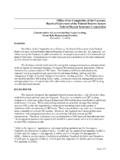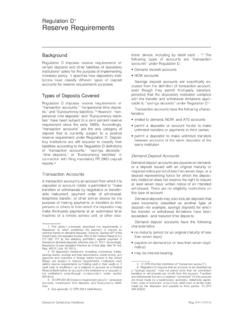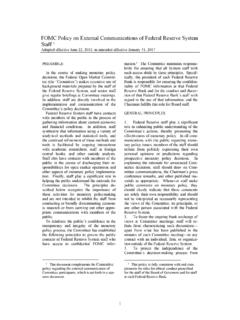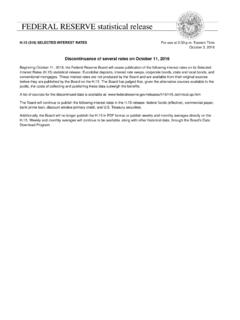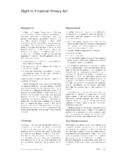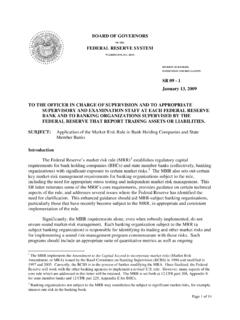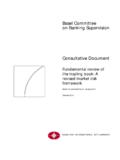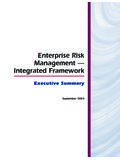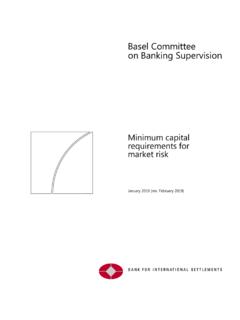Transcription of SR 13-19 / CA 13-21 attachment: Guidance on Managing ...
1 Guidance on Managing Outsourcing Risk Division of Banking Supervision and Regulation Division of Consumer and Community Affairs Board of Governors of the Federal Reserve System December 5, 2013. Table of C o n t e n t s I. Purpose 1. II. risks from the Use of Service Providers 1. III. Board of Directors and Senior Management Responsibilities 2. IV. Service Provider Risk Management Programs 2. A. Risk Assessments 3. B. Due Diligence and Selection of Service Providers 3. 1. Business Background, Reputation, and Strategy 4. 2. Financial Performance and Condition 4. 3. Operations and Internal Controls 5. C. Contract Provisions and Considerations 5. D. Incentive Compensation Review 9. E. Oversight and Monitoring of Service Providers 9. F. Business Continuity and Contingency Considerations 10. G. Additional Risk Considerations 11. I. P u r p o s e In addition to traditional core bank processing and information technology services, financial institutions1[Fotne -outsource operational activities such as accounting, appraisal management, internal audit, human resources, sales and marketing, loan review, asset and wealth management, procurement, and loan servicing.]
2 The Federal Reserve is issuing this Guidance to financial institutions to highlight the potential risks arising from the use of service providers and to describe the elements of an appropriate service provider risk management program. This Guidance supplements existing Guidance on technology service provider (TSP) risk,[Fo2tne -and applies to service provider relationships where business functions or activities are outsourced. For purposes of this Guidance , "service providers" is broadly defined to include all entities3[Fotne -that have entered into a contractual relationship with a financial institution to provide business functions or activities. II. risks f r o m t h e Use of Service Providers The use of service providers to perform operational functions presents various risks to financial institutions. Some risks are inherent to the outsourced activity itself, whereas others are introduced with the involvement of a service provider.]]
3 If not managed effectively, the use of service providers may expose financial institutions to risks that can result in regulatory action, financial loss, litigation, and loss of reputation. Financial institutions should consider the following risks before entering into and while Managing outsourcing arrangements. Compliance risks arise when the services, products, or activities of a service provider fail to comply with applicable laws and regulations. Concentration risks arise when outsourced services or products are provided by a limited number of service providers or are concentrated in limited geographic locations. Reputational risks arise when actions or poor performance of a service provider causes the public to form a negative opinion about a financial institution. For purposes of this Guidance , a "financial institution" refers to state member banks, bank and savings and loan holding companies (including their nonbank subsidiaries), and operations of foreign banking ].
4 Refer to the FFIEC Outsourcing Technology Services Booklet (June 2004) at http gov/it- ]. Entities may be a bank or nonbank, affiliated or non-affiliated, regulated or non-regulated, or domestic or ]. P a g e 1 of 12. Country risks arise when a financial institution engages a foreign-based service provider, exposing the institution to possible economic, social, and political conditions and events from the country where the provider is located. Operational risks arise when a service provider exposes a financial institution to losses due to inadequate or failed internal processes or systems or from external events and human error. Legal risks arise when a service provider exposes a financial institution to legal expenses and possible lawsuits. III. Board of D i r e c t o r s and Senior Management Responsibilities The use of service providers does not relieve a financial institution's board of directors and senior management of their responsibility to ensure that outsourced activities are conducted in a safe-and-sound manner and in compliance with applicable laws and regulations.
5 Policies governing the use of service providers should be established and approved by the board of directors, or an executive committee of the board. These policies should establish a service provider risk management program that addresses risk assessments and due diligence, standards for contract provisions and considerations, ongoing monitoring of service providers, and business continuity and contingency planning. Senior management is responsible for ensuring that board-approved policies for the use of service providers are appropriately executed. This includes overseeing the development and implementation of an appropriate risk management and reporting framework that includes elements described in this Guidance . Senior management is also responsible for regularly reporting to the board of directors on adherence to policies governing outsourcing arrangements.
6 IV. Service P r o v i d e r Risk Management Programs A financial institution's service provider risk management program should be risk- focused and provide oversight and controls commensurate with the level of risk presented by the outsourcing arrangements in which the financial institution is engaged. It should focus on outsourced activities that have a substantial impact on a financial institution's financial condition; are critical to the institution's ongoing operations; involve sensitive customer information or new bank products or services; or pose material compliance risk. The depth and formality of the service provider risk management program will depend on the criticality, complexity, and number of material business activities being outsourced. A. P a g e 2 of 12. community banking organization may have critical business activities being outsourced, but the number may be few and to highly reputable service providers.
7 Therefore, the risk management program may be simpler and use less elements and considerations. For those financial institutions that may use hundreds or thousands of service providers for numerous business activities that have material risk, the financial institution may find that they need to use many more elements and considerations of a service provider risk management program to manage the higher level of risk and reliance on service providers. While the activities necessary to implement an effective service provider risk management program can vary based on the scope and nature of a financial institution's outsourced activities, effective programs usually include the following core elements: A. Risk assessments;. B. Due diligence and selection of service providers;. C. Contract provisions and considerations;. D. Incentive compensation review.
8 E. Oversight and monitoring of service providers; and F. Business continuity and contingency plans. A. Risk Assessments Risk assessment of a business activity and the implications of performing the activity in- house or having the activity performed by a service provider are fundamental to the decision of whether or not to outsource. A financial institution should determine whether outsourcing an activity is consistent with the strategic direction and overall business strategy of the organization. After that determination is made, a financial institution should analyze the benefits and risks of outsourcing the proposed activity as well as the service provider risk, and determine cost implications for establishing the outsourcing arrangement. Consideration should also be given to the availability of qualified and experienced service providers to perform the service on an ongoing basis.
9 Additionally, management should consider the financial institution's ability and expertise to provide appropriate oversight and management of the relationship with the service provider. This risk assessment should be updated at appropriate intervals consistent with the financial institution's service provider risk management program. A financial institution should revise its risk mitigation plans, if appropriate, based on the results of the updated risk assessment. B. Due Diligence and Selection of Service Providers A financial institution should conduct an evaluation of and perform the necessary due diligence for a prospective service provider prior to engaging the service provider. The depth and formality of the due diligence performed will vary depending on the scope, complexity, and P a g e 3 of 1 2. importance of the planned outsourcing arrangement, the financial institution's familiarity with prospective service providers, and the reputation and industry standing of the service provider.
10 Throughout the due diligence process, financial institution technical experts and key stakeholders should be engaged in the review and approval process as needed. The overall due diligence process includes a review of the service provider with regard to: 1. Business background, reputation, and strategy;. 2. Financial performance and condition; and 3. Operations and internal controls. 1. Business Background, Reputation, and Strategy Financial institutions should review a prospective service provider's status in the industry and corporate history and qualifications; review the background and reputation of the service provider and its principals; and ensure that the service provider has an appropriate background check program for its employees. The service provider's experience in providing the proposed service should be evaluated in order to assess its qualifications and competencies to perform the service.


